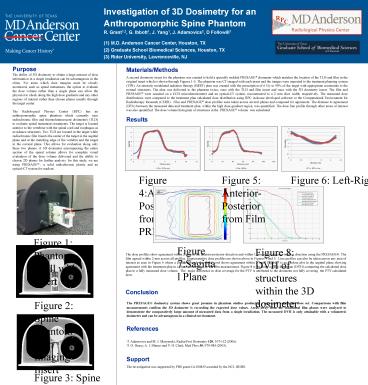Investigation of 3D Dosimetry for an - PowerPoint PPT Presentation
1 / 1
Title:
Investigation of 3D Dosimetry for an
Description:
Investigation of 3D Dosimetry for an Anthropomorphic Spine Phantom R. Grant1,2, G. Ibbott1, J. Yang1, J. Adamovics3, D Followill1 M.D. Anderson Cancer Center, Houston, TX – PowerPoint PPT presentation
Number of Views:44
Avg rating:3.0/5.0
Title: Investigation of 3D Dosimetry for an
1
- Investigation of 3D Dosimetry for an
- Anthropomorphic Spine Phantom
- R. Grant1,2, G. Ibbott1, J. Yang1, J. Adamovics3,
D Followill1 - M.D. Anderson Cancer Center, Houston, TX
- Graduate School Biomedical Sciences, Houston, TX
- Rider University, Lawrenceville, NJ
Purpose The ability of 3D dosimetry to obtain a
large amount of dose information in a single
irradiation can be advantageous in the clinic.
For areas which dose margins must be closely
monitored, such as spinal metastases, the option
to evaluate the dose volume rather than a single
plane can allow the physicist to check along the
high dose gradients and any other regions of
interest rather than chosen planes usually
through the target center. The Radiological
Physics Center (RPC) has an anthropomorphic spine
phantom which currently uses radiochromic film
and thermoluminescent dosimeters (TLD) to
evaluate spinal metastases treatments. The target
is located anterior to the vertebrae with the
spinal cord and esophagus as avoidance
structures. Two TLD are located in the target
while radiochromic film bisects the center of the
target in the sagittal plane and at the matching
edge of the vertebra and the target in the
coronal plane. This allows for evaluation along
only these two planes. A 3D dosimeter
encompassing the entire section of the spinal
column allows for complete visual evaluation of
the dose volume delivered and the ability to
choose 2D planes for further analysis. for this
study, we are using PRESAGE1, a solid
radiochromic plastic and an optical-CT system for
readout.
Materials/Methods A second dosimetry insert for
the phantom was created to hold a specially
molded PRESAGE dosimeter which matches the
location of the TLD and film in the original
insert which is shown through Figures 1-3. The
phantom was CT imaged with each insert and the
images were imported to the treatment planning
system (TPS). An intensity modulated radiation
therapy (IMRT) plan was created with the
prescription of 6 Gy to 90 of the target with
appropriate constraints to the normal structures.
The plan was delivered to the phantom twice once
with the TLD and film insert and once with the 3D
dosimetry insert. The film and PRESAGE were
scanned on a CCD microdensitometer and an
optical-CT system, reconstructed to a 2 mm slice
width, respectively. The measured dose
distributions were compared to the treatment plan
calculated dose distribution using RPC in-house
developed software or the Computational
Environment for Radiotherapy Research (CERR)2.
Film and PRESAGE dose profiles were taken across
several planes and compared for agreement. The
distance to agreement (DTA) between the measured
data and treatment plan, within the high dose
gradient region, was quantified. The dose line
profile through other areas of interest was also
quantified. The dose volume histogram of
structures in the PRESAGE volume was
calculated.
Results
Figure 4Anterior-Posterior from PRESAGE
Figure 5 Anterior-Posterior from Film
Figure 6 Left-Right through the Spinal Cord
Figure 1 Phantom Shell with insert
Figure 7Sagittal Plane
Figure 8 DVH of structures within the 3D
dosimeter
The dose profiles show agreement within 2 mm in
the anterior-posterior direction and within 1 mm
in the superior-inferior direction using the
PRESAGE. The film agreed within 2 mm across all
profiles. Representative dose profiles are shown
above in Figures 4 and 5. Line profiles can also
be taken across any area of interest as seen in
Figure 6 where a profile through the spinal cord
shows agreement within 2 mm. Figure 7 is an
isodose plot in the sagittal plane showing
agreement with the treatment plan in a plane not
covered by the film measurement. Figure 8 is the
dose volume histogram (DVH) comparing the
calculated dose plan to a fully measured dose
volume. The major difference in dose coverage
for the PTV is attributed to the dosimeter not
fully covering the PTV calculated dose.
Conclusion The PRESAGE dosimetry system shows
great promise in phantom studies producing a
measured volumetric dose set. Comparisons with
film measurements confirm the 3D dosimeter is
recording the expected dose values. Areas away
from the traditional film planes were analyzed to
demonstrate the comparatively large amount of
measured data from a single irradiation. The
measured DVH is only attainable with a volumetric
dosimeter and can be advantageous in a clinical
environment.
Figure 2 Spine Phantom with Imaging Insert
References1J. Adamovics and M. J. Maryanski,
Radiat Prot Dosimetry 120, 107-112 (2006). 2J. O.
Deasy, A. I. Blanco and V. H. Clark, Med Phys 30,
979-985 (2003).
Support The investigation was supported by PHS
grant CA100835 awarded by the NCI, DHHS.
Figure 3 Spine Phantom with PRESAGE Insert































